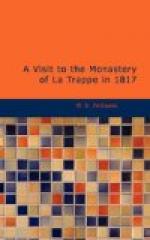days, I, perhaps, could have become an inmate of walls
which seem to have been erected to exclude the evils
of life, and to nurture only the enchanting abstractions
of unpolluted virtue and happiness: but the present
day has brought with it a general philosophy and knowledge
of human nature, which lessen the delight of contemplating
the calm repose of such a seclusion, and have taught
that these retreats from the world were not always
retreats from vice; that the sacrifices of monkish
privacy were not always those of selfish feelings;
and that the austerities once practised here, as now
at La Trappe, might perhaps arise more frequently
from disappointed pride and ambition, than from the
pure feelings of pious resignation. In the overthrow
of the monarchy and that of the priesthood, this venerable
pile became the object of popular vengeance; and had
the Revolution done no more than effected the dissolution
of the different orders of monks and nuns, every reflecting
mind must have been pleased: the removal of those
abuses, like the division of landed property into smaller
portions, (whereby the country in general became more
cultivated and productive,) was serviceable to France;
and, if any circumstance can restore permanent tranquillity,
it will be the interest which the different landholders
have in the soil and the representative system, which
will serve to check the ambition of its future governors.
Already the good effects of these are to be perceived;
and the excessive abuses, insolence, and profligacy,
of ancient ministerial oppression, which paved the
way for the downfall of the monarchy, and, like a
pestilence, destroyed that which was good with that
which was evil, will be prevented in future.
It is, nevertheless, melancholy to observe the traces
of devastation visible in all directions: the
people themselves appear not to regard it, but this
may arise partly from the long and habitual feelings
generated by the scenes to which the Revolution daily
gave rise, and partly from the constitutional cheerfulness
of the natives, who seldom view objects through the
same dark medium that ours are supposed to do, and
who, though they are not celebrated for patience, are
of all mankind the least liable to despondency.
When I spoke to M. Boderie of my regret at the destruction
of an ancient structure like the one in question,
his answer was, immediately, “oui c’est
bien malheureux; mais enfin que voulez-vous?”
He was “desole” or had “le coeur
tres sensible a tout cela;” but finished by
“il faut se consoler”. With this
sort of philosophy they are always ready to view the
past, and accept of consolation, and in amusement,
seek to bear or dissipate the calamities inseparable
from such a state of events, without even appearing
to repine. None of them will ever enter into conversation
on the subject if it can be avoided.
The following day, having taken leave of my hospitable
host, who refused any compensation, I returned to
Mortagne by another route, through the Forest of Val-Dieu,
more dark and difficult to penetrate than the other;
but the guide was better acquainted with it, and took
the road by Saint Maure and Saint Eloi, through a fine
country, highly cultivated, and abounding in beautiful
scenery and distant landscapes. It was late at
night before I reached Mortagne, greatly fatigued from
the excessive heat of the weather.




